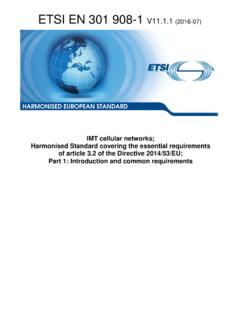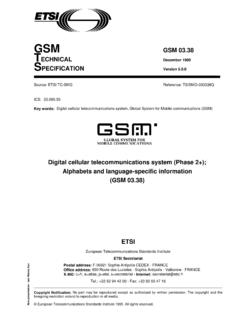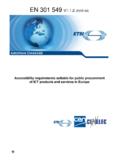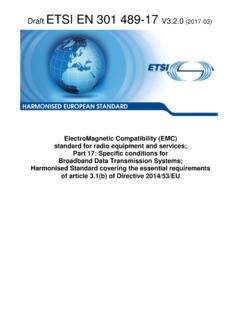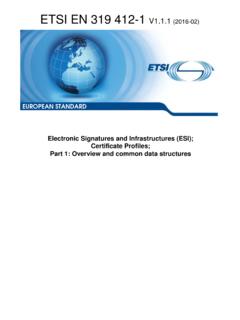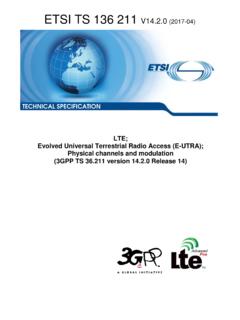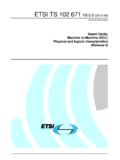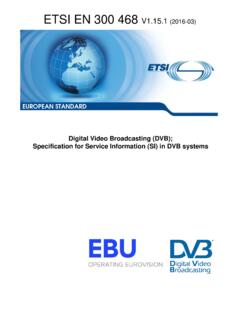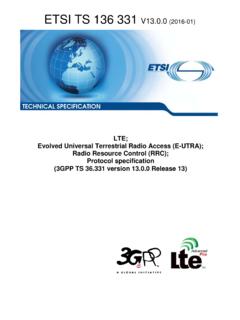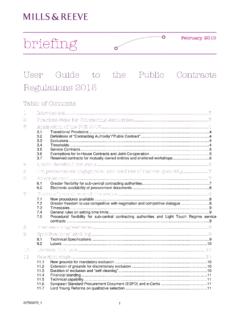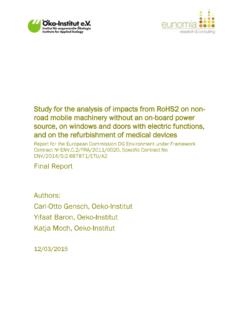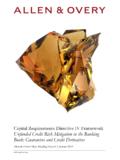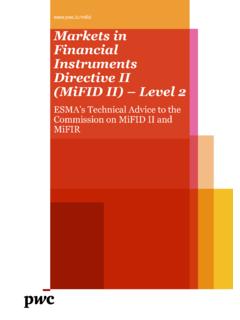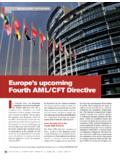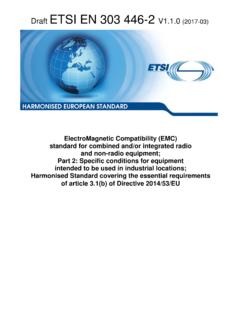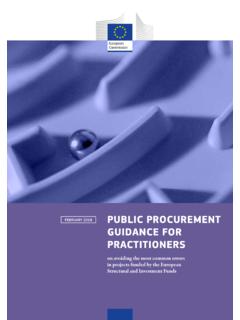Transcription of Draft ETSI EN 301 489-1 V2.2
1 Draft ETSI EN 301 489-1 (2017-03) ElectroMagnetic Compatibility (EMC) standard for radio equipment and services; Part 1: Common technical requirements; Harmonised Standard covering the essential requirements of article (b) of Directive 2014/53/EU and the essential requirements of article 6 of Directive 2014/30/EU HARMONISED EUROPEAN STANDARD ETSI Draft ETSI EN 301 489-1 (2017-03)2 Reference REN/ERM-EMC-368 Keywords EMC, harmonised standard, radio ETSI 650 Route des Lucioles F-06921 Sophia Antipolis Cedex - FRANCE Tel.: +33 4 92 94 42 00 Fax: +33 4 93 65 47 16 Siret N 348 623 562 00017 - NAF 742 C Association but non lucratif enregistr e la Sous-Pr fecture de Grasse (06) N 7803/88 Important notice The present document can be downloaded from: The present document may be made available in electronic versions and/or in print. The content of any electronic and/or print versions of the present document shall not be modified without the prior written authorization of ETSI.
2 In case of any existing or perceived difference in contents between such versions and/or in print, the only prevailing document is the print of the Portable Document Format (PDF) version kept on a specific network drive within ETSI Secretariat. Users of the present document should be aware that the document may be subject to revision or change of status. Information on the current status of this and other ETSI documents is available at If you find errors in the present document, please send your comment to one of the following services: Copyright Notification No part may be reproduced or utilized in any form or by any means, electronic or mechanical, including photocopying and microfilm except as authorized by written permission of ETSI. The content of the PDF version shall not be modified without the written authorization of ETSI. The copyright and the foregoing restriction extend to reproduction in all media. European Telecommunications Standards Institute 2017.
3 All rights reserved. DECTTM, PLUGTESTSTM, UMTSTM and the ETSI logo are Trade Marks of ETSI registered for the benefit of its Members. 3 GPPTM and LTE are Trade Marks of ETSI registered for the benefit of its Members and of the 3 GPP Organizational Partners. GSM and the GSM logo are Trade Marks registered and owned by the GSM Association. ETSI Draft ETSI EN 301 489-1 (2017-03)3 Contents Intellectual Property Rights .. 6 Foreword .. 6 Modal verbs terminology .. 8 1 Scope .. 9 2 References .. 10 Normative references .. 10 Informative references .. 11 3 Definitions, symbols and abbreviations .. 12 Definitions .. 12 Symbols .. 15 Abbreviations .. 15 4 Test conditions .. 16 General .. 16 Arrangements for test signals .. 16 General .. 16 Arrangements for test signals at the input of transmitters .. 16 Arrangements for test signals at the RF output of transmitters .. 16 Arrangements for test signals at the RF input of receivers .. 17 Arrangements for test signals at the output of receivers.
4 17 Arrangements for testing transmitter and receiver together (as a system) .. 17 RF exclusion band of radio equipment .. 18 General .. 18 Exclusion band for transmitters or the transmitter part of 18 General .. 18 Channelized Equipment .. 18 Non-Channelized Equipment .. 18 Exclusion band for receivers or the receiver part of transceivers .. 18 18 Channelized Equipment .. 18 Non-Channelized Equipment .. 19 Narrow band responses of receivers or receivers which are part of transceivers .. 19 Normal test modulation .. 19 5 Performance assessment .. 20 General .. 20 Equipment which can provide a continuous communication link .. 20 Equipment which does not provide a continuous communication link .. 21 Ancillary equipment .. 21 Equipment classification .. 21 6 Performance criteria .. 22 Introduction .. 22 Performance criteria for continuous phenomena applied to transmitters and receivers .. 22 Performance criteria for transient phenomena applied to transmitters and receivers.
5 22 Performance criteria for equipment which does not provide a continuous communication link .. 23 Performance criteria for ancillary equipment tested on a stand alone basis .. 23 7 Applicability overview tables .. 23 Introduction .. 23 EMC emission .. 24 Immunity .. 24 8 Methods of measurement and limits for EMC emissions .. 25 Test 25 Enclosure port of ancillary equipment measured on a stand alone basis .. 25 General .. 25 ETSI Draft ETSI EN 301 489-1 (2017-03)4 Test method .. 26 Limits .. 26 DC power input/output ports .. 26 General .. 26 Test method .. 26 Limits .. 27 AC mains power input/output ports .. 27 General .. 27 Test method .. 27 Limits .. 28 General .. 28 AC Power port used for power supply only .. 28 AC power input port also used for PLC Communications .. 28 Harmonic current emissions (AC mains input port) .. 28 Voltage fluctuations and flicker (AC mains input port) .. 28 Wired network ports.
6 28 General .. 28 Test method .. 28 Limits .. 29 9 Test methods and levels for immunity tests .. 29 Test 29 Radio frequency electromagnetic field (80 MHz to 6 000 MHz) .. 29 General .. 29 Test method .. 30 Performance criteria .. 30 Electrostatic discharge .. 30 General .. 30 Test method .. 30 Performance criteria .. 31 Fast transients, common mode .. 31 General .. 31 Test method .. 31 Performance criteria .. 31 Radio frequency, common mode .. 32 General .. 32 Test method .. 32 Performance criteria .. 32 Transients and surges in the vehicular environment .. 33 General .. 33 Test method .. 33 Performance criteria .. 33 Voltage dips and interruptions .. 33 General .. 33 Test method .. 33 Performance criteria .. 34 Surges .. 34 General .. 34 Test method .. 35 General .. 35 Test method for wired network ports directly connected to outdoor cables .. 35 Test method for wired network ports connected to indoor cables.
7 35 Test method for mains ports .. 35 Performance criteria .. 35 Annex A (informative): Relationship between the present document and the essential requirements of Directive 2014/53/EU and Directive 2014/30/EU .. 36 Relationship between the present document and the essential requirements of Directive 2014/53/EU .. 36 Relationship between the present document and the essential requirements of Directive 2014/30/EU .. 37 ETSI Draft ETSI EN 301 489-1 (2017-03)5 Annex B (normative): Application of harmonised EMC standards to multi-radio and multi-standard-radio equipment .. 39 Introduction .. 39 Multi-radio equipment capable of independent 39 Multi-radio equipment and multi-standard-radio equipment not capable of independent transmission .. 39 Multi-radio equipment comprising of numerous identical radio transmitters .. 39 Annex C (informative): Bibliography .. 40 Annex D (informative): Change history .. 41 History .. 42 ETSI Draft ETSI EN 301 489-1 (2017-03)6 Intellectual Property Rights IPRs essential or potentially essential to the present document may have been declared to ETSI.
8 The information pertaining to these essential IPRs, if any, is publicly available for ETSI members and non-members, and can be found in ETSI SR 000 314: "Intellectual Property Rights (IPRs); Essential, or potentially Essential, IPRs notified to ETSI in respect of ETSI standards", which is available from the ETSI Secretariat. Latest updates are available on the ETSI Web server ( ). Pursuant to the ETSI IPR Policy, no investigation, including IPR searches, has been carried out by ETSI. No guarantee can be given as to the existence of other IPRs not referenced in ETSI SR 000 314 (or the updates on the ETSI Web server) which are, or may be, or may become, essential to the present document. Foreword This Draft Harmonised European Standard (EN) has been produced by ETSI Technical Committee Electromagnetic compatibility and Radio spectrum Matters (ERM), and is now submitted for the combined Public Enquiry and Vote phase of the ETSI standards EN Approval Procedure. The present document has been prepared under the Commission's standardisation request C(2015) 5376 final [ ] to provide one voluntary means of conforming to the essential requirements of Directive 2014/53/EU on the harmonisation of the laws of the Member States relating to the making available on the market of radio equipment and repealing Directive 1999/5/EC [ ].
9 The present document has been prepared under the Commission's standardisation request C(2016) 7641 final [ ] to provide one voluntary means of conforming to the essential requirements of Directive 2014/30/EU on the harmonisation of the laws of the Member States relating to electromagnetic compatibility (recast) [ ]. Once the present document is cited in the Official Journal of the European Union under the Directives, compliance with the normative clauses of the present document given in tables and confers, within the limits of the scope of the present document, a presumption of conformity with the corresponding essential requirements of the corresponding Directives and associated EFTA regulations. The present document is part 1 of a multi-part EMC standard for radio equipment which is structured in the following way: One EMC standard for all radio equipment made up of several parts. All common technical requirements for EMC emission and immunity have been placed in the common part, which is the present document.
10 Separate parts have been developed to cover specific product related radio equipment test conditions, test arrangements, performance assessment, performance criteria, etc. A clause is included in each of the specific radio parts, entitled "special conditions", which is used as appropriate to cover any deviations or additions to the common requirements set out in the present document. The present document is part 1 of a multi-part deliverable covering ElectroMagnetic Compatibility (EMC) standard for radio equipment and services, as identified below: Part 1: "Common technical requirements; Part 2: "Specific conditions for radio paging equipment"; Part 3: "Specific conditions for Short-Range Devices (SRD) operating on frequencies between 9 kHz and 246 GHz"; Part 4: "Specific conditions for fixed radio links and ancillary equipment"; Part 5: "Specific conditions for Private land Mobile Radio (PMR) and ancillary equipment (speech and non-speech) and Terrestrial Trunked Radio (TETRA)"; Part 6: "Specific conditions for Digital Enhanced Cordless Telecommunications (DECT) equipment"; ETSI Draft ETSI EN 301 489-1 (2017-03)7 Part 9: "Specific conditions for wireless microphones, similar Radio Frequency (RF) audio link equipment, cordless audio and in-ear monitoring devices".
